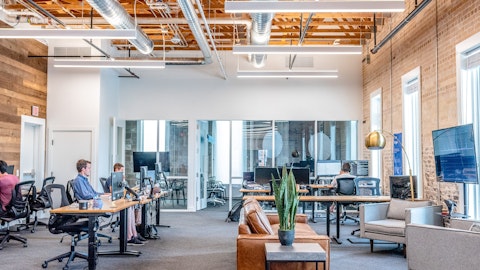And so I think once those things kind of level normalized, I think that will be a key driver for us and especially because that pipeline is picking up.
Taylor Greenwald: And Bob, I’ll just add in terms of the migration, it certainly has contributed. We’ve had very nice gross margin improvement over the past year. It’s gone from about 25% in the first quarter of 2023 to 29% this quarter. And the shift to offshore has certainly helps us improve that gross margin as well as operate improvements we’ve made in the U.S.
Dave Koning: Got you. Tanks for that and then maybe just as a follow-up question. You’ve had a lot of years where you’ve grown very well, right around 10% or so. In a normal year like that, how much of the growth is from existing and how much is from new? And then in a year like this, how does that change? And then do you think you’ll get back to normal by next year, maybe even late this year?
Bob Dechant: Yes. We’re hoping that we can get – and again, the market is a little bit tough, Dave, right? So in all, so can we get to double-digit in the back half of the year in Q4 or into 2025? I’m not quite sure we’re there yet. But can we get into upper single-digits, that’s what we’re hopeful for. In fact, if things keep progressing on the pipeline, we feel good about just how that trajectory adds up. And if you look at, Dave, I kind of look and say, and we’ve shared these numbers in past, our new logo revenue has ranged in the $30 million to $50 million in your revenue over the last, let’s say, kind of three, four years-ish. And so as we kind of move from a $400 million to $500 million company, you can just kind of do that math, $30 million, $40 million, $50 million, of the $400 million, $500 million also that adds in, in year, [ph] about 10% growth.
But more importantly, as you know, those clients do have historically done 2.5 times in a year or two. So that usually – you put those two things together, and that has given strong growth for us. And we think we’re in a good position to have our business structurally look like that down the road.
Dave Koning: Got you. That’s helpful. Great job on margins and cash flow, too.
Bob Dechant: Yes, we’re excited about what we’ve done here structurally as a company that just – it’s really – we’re proud of that.
Dave Koning: Yes. Great to see. Thanks guys.
Bob Dechant: Thank you.
Operator: Thank you. [Operator Instructions] Our next question comes from the line of Matthew Roswell of RBC. Your line is open.
Matthew Roswell: Yes. Congratulations on a nice quarter. I have three questions; sorry about that, all revolving around the large wins. And I guess the three of them are first, you mentioned that they were very competitive. So can you talk about pricing and competition for those wins for the large wins and then in general? Second part of the question is the analytics piece, is that – do you think that will become stable stakes to winning new deals relatively soon? And the final question for Taylor is, you had mentioned the ramp towards the back half of the year. How should we think about sort of the seasonality of the revenues, are they large enough to kind of move the needle? Thank you.
Bob Dechant: Great. So let me take the – Matt, thank you and thanks for those questions and joining. Let me take the first two, and then Taylor will bounce over to you, if that makes sense. But – so the deals that I talked about, especially the large deals are very, very competitive. And again, I would just sit and say, think of the big multibillion dollar players, the $10 billion multiplayers toe-to-toe in those. And so I like to call those on Broadway deals. And what both of them – one common thing that we had in both of those and one was a near-shore deal and one was a provincial Philippine deal was the decision and your position around – and your ability to deliver generative AI solutions in this one case, as I highlighted, the smart IVR that then has chatbots and voicebots in the front end of the experience and being able to deliver those; that was key.
And if we bring it out light on that versus the other folks, there’s no way we would have won that. And if I go back a year ago, that would never been in anybody’s decision-making process. So its front and center and the other deal, and we’re implementing that immediately. The other deal was very similar, but it’s kind of like Page 2 [ph] for them. And so what I love is in that area of the business, we’re going, head up against a multibillion dollar players [indiscernible]. And we’re beating them because we have the BPO 2.0 capabilities, the culture, the analytics, the branding, all of that, the Wave X Technology and now AI, and we’re not taking a backseat, and that’s why I love about what we’ve done. And therefore, the pricing is – it’s not front and center.
You have to be competitive. We think that with – and again, think of this, these experiences now become [indiscernible] experiences. They are lower cost than [indiscernible] experiences, but it’s just an extension. The way I look at this, it’s just an extension of the transactions that we do with human folks, but now we get paid and – but we’re using technology to do that and you monetize it. And we think that, that is the visual, or I have is that is higher margin. So when you put all of that together, that’s why we’re bullish on this. And I know the market looks at AI as around BPO as a risk. But that solution is clearly an extension of what we do, and that’s why we’re excited about that. And that’s why pricing is competitive. It’s – you don’t have – you’re not winning on low pricing, let me put it that way, you just – we hold around.



